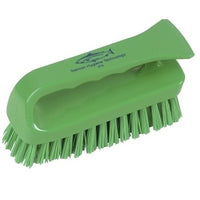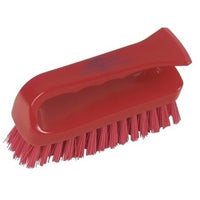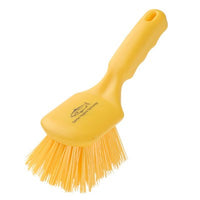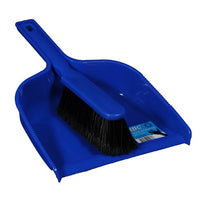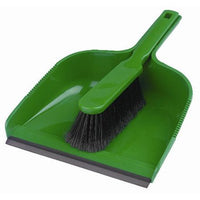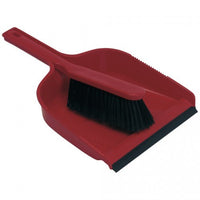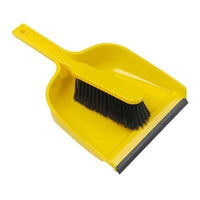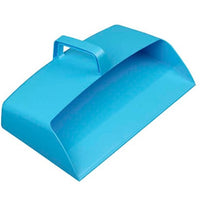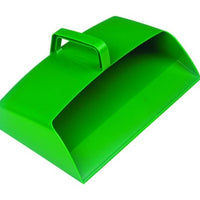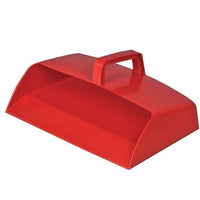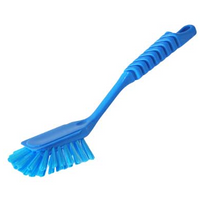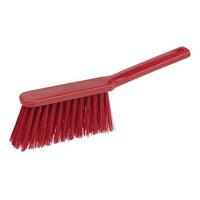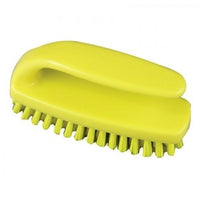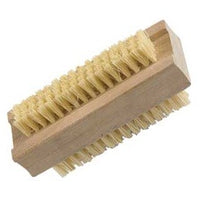Collection: Hand Brushes
Discover our extensive range of professional handheld brushware designed for both domestic and commercial cleaning applications. From soft hand brushes for delicate surfaces to stiff bassine brushes for heavy-duty scrubbing, our collection features products from trusted brands including SYR, Hillbrush, and Robert Scott. Each brush is engineered to meet the highest standards of hygiene and durability, with colour-coded options available to support HACCP compliance and prevent cross-contamination. Whether you're maintaining a commercial kitchen, cleaning facility, or simply keeping your home spotless, our handheld brushware provides the reliability and performance you need for effective cleaning across all surfaces and applications.
Handheld Brushware Product information
Hand-held brushes are a vital part of any cleaning kit, and it is important you have the right kind available for the task. We have brushes for cleaning the floor, the toilet, dusting and even for cleaning yourself! From top professional brands including SYR, Hillbrush and Robert Scott.
Effective cleaning depends on selecting appropriate handheld brushware that matches surface requirements, contamination levels, and application demands. Modern brush technology combines traditional materials with advanced construction methods to deliver superior cleaning performance whilst addressing hygiene, durability, and efficiency concerns across diverse cleaning environments.
At ClickCleaning, we provide comprehensive handheld brushware solutions designed to meet varied cleaning requirements across all environments. Our carefully selected range includes Soft Hand Brushes available in blue, green, red, and yellow for colour-coded systems, Stiff Hand Brushes in matching colours for heavy-duty applications, Nylon Hand Brushes for chemical resistance, Tampico Upholstery Brushes for fabric care, Bassine Hand Brushes for outdoor cleaning, Grout Brushes for detailed work, and specialist brushes including Prochem spotting brushes and double wing scrubs for professional
applications.
The selection of appropriate handheld brushware depends on understanding the relationship between bristle materials, surface characteristics, and cleaning requirements. Soft bristles excel at delicate surface cleaning and fine particle removal, whilst stiff bristles provide aggressive action for heavy
soiling and textured surfaces. Brush size affects precision and coverage, with smaller brushes enabling detailed work whilst larger brushes improve efficiency for area cleaning.
Soft Hand Brushes represent versatile cleaning tools optimised for delicate surfaces and maintenance cleaning applications. The soft bristle construction prevents surface damage whilst providing effective debris removal and cleaning action across various materials.
Available in blue, green, red, and yellow colour-coding, these brushes support professional hygiene systems that prevent cross-contamination between
different cleaning areas. The colour-coding system ensures cleaning equipment used in one area never comes into contact with other areas where contamination could spread.
Blue designation typically indicates general cleaning areas including offices, reception spaces, and public areas. The dedicated blue equipment ensures contamination control whilst providing effective cleaning performance for routine maintenance tasks.
Green designation indicates food preparation and kitchen areas where maintaining hygiene standards is paramount. The dedicated green equipment ensures contamination cannot transfer from other areas to food preparation zones, supporting HACCP compliance.
Red designation is reserved for high-risk areas including toilets, washrooms, and sanitary facilities. The dedicated red equipment prevents contamination transfer whilst providing effective cleaning action for challenging hygiene applications.
Yellow designation indicates clinical areas, infectious zones, and high-hygiene environments where contamination control is critical. The dedicated yellow equipment supports infection control measures whilst maintaining cleaning effectiveness.
Soft bristle construction utilises synthetic materials that provide consistent performance, chemical resistance, and hygiene advantages over natural alternatives. The synthetic fibres resist bacterial growth whilst maintaining cleaning effectiveness through multiple cleaning cycles.
Stiff Hand Brushes provide aggressive cleaning action for heavy-duty applications involving stubborn soils, textured surfaces, and challenging debris removal. The firm bristle construction maintains shape under pressure whilst delivering superior scrubbing performance.
Available in matching blue, green, red, and yellow colour-coding, stiff brushes extend contamination control benefits to demanding cleaning applications. The colour-coding system ensures appropriate equipment selection whilst preventing cross-contamination between different areas.
Stiff bristle construction provides maximum cleaning effectiveness for challenging applications including grout cleaning, textured surface maintenance, and heavy soil removal. The robust construction withstands aggressive scrubbing action whilst maintaining bristle integrity.
Surface compatibility suits rough textures, outdoor applications, and areas requiring aggressive cleaning action. The stiff bristles penetrate surface irregularities effectively whilst removing embedded debris that softer brushes cannot address.
Nylon Hand Brushes offer superior chemical resistance and durability for applications involving cleaning chemicals, solvents, and demanding cleaning environments. The nylon construction provides excellent bend recovery whilst maintaining cleaning effectiveness through extended use.
Chemical resistance makes nylon brushes ideal for applications involving acids, alkalis, and cleaning solutions that might damage natural bristles. The
synthetic material maintains performance characteristics whilst resisting chemical degradation.
Durability advantages include excellent abrasion resistance, superior bend recovery, and consistent performance through multiple cleaning cycles. The
nylon construction maintains bristle integrity whilst delivering reliable cleaning action.
Temperature resistance enables use in demanding environments where heat exposure might damage other materials. Nylon bristles maintain performance
characteristics across varying temperature conditions.
Tampico Upholstery Hand Brushes provide gentle cleaning action specifically designed for fabric care and upholstery maintenance. The natural tampico fibres offer optimal balance between cleaning effectiveness and fabric protection.
Tampico construction utilises natural fibres derived from Mexican Agave plants, providing soft to medium texture with excellent liquid absorption properties. The natural material offers superior cleaning action whilst remaining gentle on delicate fabrics.
Upholstery applications benefit from the gentle agitation provided by tampico fibres, which lift embedded dirt and debris without causing fabric damage. The natural bristles conform to fabric textures whilst providing effective cleaning action.
Liquid absorption properties enable effective cleaning with minimal moisture, preventing over-wetting that could damage fabrics or cause shrinkage. The natural fibres absorb cleaning solutions whilst distributing them evenly across surfaces.
Stiff Bassine Hand Brushes deliver maximum cleaning power for demanding outdoor applications and heavy-duty cleaning tasks. The natural bassine fibres
provide exceptional durability whilst maintaining aggressive cleaning action.
Bassine construction utilises palm leaf fibres that provide naturally stiff characteristics ideal for challenging cleaning applications. The natural
material offers superior durability whilst maintaining consistent cleaning performance.
Outdoor applications benefit from bassine's weather resistance and durability under harsh conditions. The natural fibres handle moisture, temperature variations, and aggressive use whilst maintaining cleaning effectiveness.
Heavy-duty cleaning capability includes removing stubborn debris, cleaning textured surfaces, and applications requiring maximum scrubbing action. The stiff bristles provide superior cleaning performance for demanding tasks.
Grout Brushes in 225mm blue provide specialist cleaning capability for detailed work in tile installations, bathroom maintenance, and precision cleaning applications. The narrow profile enables effective cleaning in confined spaces whilst maintaining aggressive cleaning action.
Grout-specific design features narrow profile that fits between tiles whilst providing effective cleaning action for removing soap scum, mildew, and accumulated debris. The specialised design ensures thorough cleaning in challenging areas.
Blue colour-coding supports general cleaning applications whilst providing visual identification that prevents cross-contamination. The dedicated colour
ensures appropriate equipment selection for specific cleaning tasks.
Length specification at 225mm provides optimal balance between reach and control for detailed grout cleaning applications. The size enables effective
cleaning whilst maintaining precision for detailed work.
Grippy Hygiene Scrub Brushes incorporate advanced handle technology that provides secure grip even in wet conditions. Available in blue and yellow colour-coding, these brushes ensure safe handling whilst maintaining contamination control.
Grippy handle technology features textured surfaces and ergonomic design that prevents slippage during use. The secure grip reduces fatigue whilst
improving cleaning effectiveness through better control.
Hygiene applications benefit from the combination of secure handling and effective cleaning action. The brushes provide thorough cleaning whilst
maintaining safety standards in wet environments.
Colour-coded availability in blue and yellow extends contamination control benefits to demanding hygiene applications. The visual identification system ensures appropriate equipment selection whilst preventing cross-contamination.
Medium Grippy Nail Brushes in red provide personal hygiene capability with advanced grip technology for secure handling. The compact size enables detailed cleaning whilst maintaining colour-coding benefits.
Personal hygiene applications require compact size with effective cleaning action for thorough hand and nail cleaning. The brush design provides
comprehensive cleaning whilst remaining comfortable to use.
Red colour-coding indicates bathroom and personal hygiene applications, ensuring equipment remains dedicated to appropriate areas. The colour system
prevents contamination whilst providing effective cleaning capability.
Grippy technology ensures secure handling even with wet or soapy hands, improving safety whilst maintaining cleaning effectiveness. The textured grip
reduces slippage whilst providing comfortable use.
Double Wing Scrub Brushes in blue and red provide advanced cleaning capability with dual-sided bristle configuration for versatile cleaning applications. The innovative design enables effective cleaning from multiple angles.
Double wing design features bristles on opposing sides that provide comprehensive cleaning action whilst enabling access to difficult areas. The
configuration improves cleaning effectiveness whilst reducing cleaning time.
Colour-coded availability in blue and red ensures appropriate equipment selection for different cleaning areas. The visual identification system supports contamination control whilst providing versatile cleaning capability.
Versatile applications include general cleaning, bathroom maintenance, and detailed work where multiple cleaning angles improve effectiveness. The design reduces cleaning time whilst improving results.
Prochem Spotting Brushes provide specialist cleaning capability for carpet care and upholstery maintenance. The professional-grade construction ensures
effective spot cleaning whilst maintaining material integrity.
Professional applications benefit from the specialised design that provides effective cleaning action for spot treatment without causing damage to carpets or upholstery. The brush design supports professional cleaning standards.
Carpet care applications require gentle yet effective cleaning action that removes stains without damaging fibres. The brush construction provides optimal
balance between cleaning effectiveness and material protection.
Upholstery maintenance benefits from the precision cleaning capability that enables spot treatment whilst maintaining fabric integrity. The professional design ensures effective cleaning without causing damage.
Prochem Velvet Boffin Brushes provide specialist capability for delicate fabric care and precision cleaning applications. The advanced construction ensures effective cleaning whilst maintaining material protection.
Velvet care requires extremely gentle cleaning action that removes debris without damaging delicate fibres. The specialised brush construction provides
effective cleaning whilst maintaining fabric integrity.
Precision applications benefit from the controlled cleaning action that enables detailed work without causing damage. The brush design supports
professional cleaning standards for delicate materials.
Professional-grade construction ensures reliable performance whilst maintaining gentle cleaning action. The quality construction provides consistent results for demanding applications.
Handle compatibility across the range ensures optimal ergonomics and cleaning effectiveness. Proper handle selection affects operator comfort, cleaning performance, and equipment longevity.
Ergonomic considerations include handle length, grip comfort, and weight distribution that reduce operator fatigue whilst improving cleaning effectiveness. Proper ergonomics support extended use without discomfort.
Durability factors include handle material, construction quality, and connection strength that ensure reliable performance under demanding conditions. Quality construction prevents failure whilst maintaining effectiveness.
Colour-coded handles extend contamination control benefits to complete brush assemblies. Matching handle and brush colours ensure equipment remains
dedicated to appropriate areas.
Material selection encompasses polypropylene handles for chemical resistance, wooden handles for traditional applications, and composite handles for specialised requirements. Each material provides specific advantages for different applications.
Surface compatibility considerations affect brush selection for optimal cleaning performance whilst preventing damage. Understanding surface characteristics ensures effective cleaning without causing problems.
Delicate surfaces including polished materials, sealed surfaces, and sensitive finishes require soft bristles that provide effective cleaning whilst preventing scratching or damage. Appropriate brush selection prevents costly surface damage.
Textured surfaces including rough materials, outdoor surfaces, and industrial applications require stiff bristles that penetrate irregularities whilst removing embedded debris. Proper brush selection ensures effective cleaning performance.
Chemical compatibility affects brush selection when using cleaning solutions. Understanding chemical effects on different bristle materials ensures safe use whilst maintaining cleaning effectiveness.
Maintenance requirements vary by brush type and application intensity. Proper maintenance significantly extends brush life whilst ensuring consistent
cleaning performance throughout the service period.
Cleaning protocols include removing debris after use, appropriate washing procedures, and thorough drying to prevent bacterial growth. Regular
maintenance maintains performance whilst ensuring hygiene standards.
Storage considerations include clean, dry conditions that prevent bristle deformation and contamination. Proper storage extends brush life whilst maintaining cleaning effectiveness.
Replacement timing depends on performance degradation rather than appearance. Replace brushes when cleaning effectiveness declines, regardless of
visual condition.
Whether you're maintaining commercial facilities, ensuring hygiene protocols in professional environments, or tackling demanding cleaning challenges,
ClickCleaning's handheld brushware provides the performance, durability, and contamination control necessary for superior cleaning results across all
applications.
Please contact us if you have any questions about our range we can assist with.
Handheld Brushware FAQs
What's the difference between soft and stiff hand brushes?
The fundamental difference lies in bristle construction and cleaning applications, with each type optimised for specific surface requirements and cleaning challenges.
Soft hand brushes feature flexible bristles that bend easily under pressure, making them ideal for delicate surfaces where scratching would be problematic. These brushes excel at removing dust, fine debris, and light soiling whilst protecting polished surfaces, sealed materials, and sensitive finishes from damage.
Stiff hand brushes use rigid bristles that maintain their shape under pressure, providing aggressive cleaning action for challenging applications. These brushes can penetrate surface irregularities, dislodge stubborn debris, and provide the scrubbing power necessary for heavy-duty cleaning tasks.
Surface compatibility is crucial for selection. Soft brushes work best on polished floors, sealed surfaces, upholstery, and any area where surface protection is paramount. They effectively remove debris without causing scratches or damage to sensitive materials.
Stiff brushes are ideal for textured surfaces, outdoor applications, grout cleaning, and areas requiring aggressive cleaning action. They can handle challenging debris, embedded soils, and applications where gentle cleaning would be ineffective.
Debris characteristics affect performance significantly. Light materials like dust and fine particles are effectively captured by soft bristles, whilst heavy debris, adherent soils, and stubborn stains require the aggressive action of stiff bristles.
Application frequency influences selection. Areas requiring frequent maintenance cleaning often benefit from soft brushes that provide gentle yet effective cleaning. Areas needing occasional deep cleaning may require stiff brushes for thorough soil removal.
Many professional operations use both types strategically. Soft brushes for routine maintenance and delicate surfaces, combined with stiff brushes for heavy-duty cleaning and challenging applications, provide comprehensive cleaning capability.
How do I choose the right colour-coded brush for my facility?
Colour-coded brush selection requires understanding contamination risks and implementing systematic approaches that prevent cross-contamination between different areas.
The standard colour-coding system designates specific colours for different risk levels and applications. Red indicates high-risk areas including toilets and washrooms, blue represents general cleaning areas, green designates food preparation zones, and yellow indicates clinical or infectious areas.
Risk assessment forms the foundation of colour selection. Identify areas with different contamination levels and assign appropriate colours based on the risk of cross-contamination. High-risk areas require dedicated equipment that never contacts other areas.
Food service operations typically use green for food preparation areas, blue for dining and public areas, and red for restrooms. This system prevents contamination between food contact surfaces and other areas.
Healthcare facilities often require more complex colour coding with yellow for clinical areas, red for high-risk zones, blue for general areas, and green for food service areas. The system supports infection control measures.
Commercial cleaning operations benefit from comprehensive colour coding that covers all areas within facilities. Different colours for offices, restrooms, food areas, and general cleaning ensure contamination control across diverse environments.
Training requirements are essential for system success. All staff must understand which colours belong in which areas and why the system matters for health and safety. Regular training reinforces proper procedures.
Storage systems must support colour coding by keeping different coloured equipment separate. Dedicated storage areas or clearly marked sections prevent accidental mixing of equipment between areas.
Inventory management requires adequate stock levels in each colour to prevent the temptation to use incorrect colours when preferred equipment is unavailable. Better to have redundancy than compromise hygiene.
Documentation helps in regulated environments. Recording colour-coding systems, training records, and compliance procedures demonstrates commitment to contamination control.
What are tampico bristles and why are they used in upholstery brushes?
Tampico bristles are natural fibres derived from the Mexican Agave plant, specifically selected for their unique properties that make them ideal for upholstery care and delicate cleaning applications.
The natural origin provides inherent characteristics that synthetic materials struggle to replicate. Agave plants develop fibres with optimal balance between cleaning effectiveness and gentleness, making them perfect for fabric care applications.
Liquid absorption properties are exceptional due to tampico's porous fibre structure. This enables effective cleaning with minimal moisture, preventing over-wetting that could damage fabrics or cause shrinkage problems.
Gentle cleaning action results from tampico's natural flexibility and texture. The fibres conform to fabric surfaces whilst providing effective agitation that lifts embedded dirt and debris without causing damage to delicate materials.
Chemical resistance makes tampico suitable for use with appropriate cleaning solutions. The natural fibres resist degradation from acids and alkalis commonly found in upholstery cleaning products.
Temperature stability enables use across varying environmental conditions. Tampico maintains performance characteristics in both warm and cool conditions, providing consistent cleaning action regardless of ambient temperature.
Fibre structure provides natural cleaning effectiveness. The slightly irregular surface texture grips debris effectively whilst the natural taper enables gentle cleaning action that synthetic alternatives cannot match.
Durability characteristics include excellent resistance to wear and maintaining effectiveness through multiple cleaning cycles. Quality tampico brushes provide long service life whilst maintaining cleaning performance.
Environmental considerations favour tampico as a renewable resource. Agave plants regenerate naturally, making tampico an environmentally responsible choice compared to synthetic alternatives.
Applications where tampico excels include upholstery cleaning, carpet spot treatment, fabric care, and any application requiring gentle yet effective cleaning action on delicate materials.
How do I maintain handheld brushes for maximum lifespan?
Proper brush maintenance significantly extends equipment life whilst ensuring consistent cleaning performance throughout the service period.
Daily maintenance begins with removing debris from bristles after each use. Shake out loose particles and use a comb or stiff brush to remove stubborn materials that could damage bristles or harbour bacteria.
Cleaning procedures vary by brush type and application. Soft brushes require gentle cleaning that preserves bristle integrity, whilst stiff brushes can handle more aggressive cleaning procedures.
Rinsing protocols should use clean water to remove cleaning solution residues that could damage bristles or attract dirt. Thorough rinsing prevents chemical buildup that reduces cleaning effectiveness.
Drying requirements are crucial for all brush types. Ensure complete drying before storage to prevent bacterial growth, odour development, and bristle deterioration. Air drying is typically safest for maintaining bristle integrity.
Storage conditions significantly affect brush lifespan. Store in clean, dry areas away from extreme temperatures and direct sunlight. Hanging storage prevents bristle deformation whilst keeping brushes away from contaminated surfaces.
Bristle care includes avoiding contact with sharp objects that could cut fibres and preventing compression from heavy objects that could cause permanent bristle deformation.
Handle maintenance involves checking connections between handle and brush head, ensuring secure attachment that prevents separation during use. Replace damaged handles before they fail completely.
Usage considerations affect maintenance needs. Avoid using brushes on inappropriate surfaces that could cause excessive wear, and don't use brushes for tasks they're not designed for.
Regular inspection helps identify problems early. Check for bristle loss, deformation, reduced cleaning effectiveness, or any damage that indicates replacement needs.
Chemical compatibility requires understanding how cleaning solutions affect different brush materials. Use appropriate cleaning products that won't damage bristles or reduce effectiveness.
What's the difference between nylon and natural bristle brushes?
Understanding the differences between nylon and natural bristle brushes helps ensure optimal brush selection for specific cleaning applications and environmental requirements.
Nylon bristles are synthetic fibres that provide consistent performance, superior chemical resistance, and excellent durability across diverse cleaning applications. The synthetic construction offers predictable characteristics that don't vary with environmental conditions.
Natural bristles, including tampico and bassine, offer unique properties derived from plant fibres that provide specific advantages for certain applications. Natural materials often provide superior cleaning action for specialised tasks.
Chemical resistance strongly favours nylon bristles, which resist degradation from acids, alkalis, solvents, and most cleaning chemicals. Natural bristles may be damaged by certain chemicals, limiting their application range.
Durability characteristics vary by application. Nylon provides consistent performance through multiple cleaning cycles and maintains bristle integrity under demanding conditions. Natural bristles may offer superior performance in specific applications but require more careful maintenance.
Temperature resistance is typically superior with nylon bristles, which maintain performance characteristics across wide temperature ranges. Natural bristles may be affected by extreme temperatures, limiting their application range.
Cleaning effectiveness depends on application requirements. Nylon provides consistent performance across diverse tasks, whilst natural bristles may excel in specific applications like upholstery care or delicate surface cleaning.
Moisture resistance favours nylon bristles, which don't absorb water and maintain stiffness in wet conditions. Natural bristles may absorb moisture, affecting their cleaning characteristics.
Environmental considerations include the renewable nature of natural bristles versus the recyclability and longevity of nylon alternatives. Both materials have environmental advantages depending on specific applications.
Cost considerations include both initial price and service life. Nylon brushes may cost more initially but often provide better value through extended service life and consistent performance.
Application selection should consider cleaning requirements, environmental conditions, and performance expectations. Nylon excels in demanding, chemical-intensive applications, whilst natural bristles provide superior performance for specialised tasks.
How do I choose the right brush size for detailed cleaning work?
Brush size selection for detailed cleaning work requires balancing precision requirements with efficiency considerations to achieve optimal cleaning results.
Small brushes provide maximum precision for detailed work, enabling access to confined spaces and intricate areas where larger brushes would be ineffective. These brushes excel at spot cleaning, precision work, and applications requiring careful control.
Medium brushes offer balance between precision and efficiency, providing good control whilst covering more area than smaller brushes. They're ideal for detailed work that covers substantial areas.
Large brushes maximise efficiency for extensive detailed cleaning projects, providing good precision whilst covering significant areas quickly. They're suitable for detailed work across large surfaces.
Access requirements often determine appropriate brush size. Confined spaces, intricate areas, and detailed work around obstacles require smaller brushes that can manoeuvre effectively.
Precision requirements affect size selection. Applications requiring extremely precise cleaning action benefit from smaller brushes that provide maximum control and accuracy.
Efficiency considerations include the time required to complete detailed cleaning tasks. Larger brushes may complete work faster whilst smaller brushes provide better precision.
Operator comfort influences practical brush size limits. Smaller brushes may cause hand fatigue during extended use, whilst larger brushes may be difficult to control for precision work.
Surface characteristics affect optimal brush size. Intricate surfaces with many details require smaller brushes, whilst detailed work on smoother surfaces may accommodate larger brushes.
Debris characteristics influence brush size selection. Fine debris and detailed cleaning tasks often require smaller brushes for effective removal, whilst larger debris may be handled efficiently by larger brushes.
Application frequency affects size selection. Frequent detailed cleaning may benefit from slightly larger brushes for efficiency, whilst occasional precision work may require smaller brushes for optimal results.
What makes bassine brushes suitable for outdoor cleaning?
Bassine brushes offer unique characteristics that make them exceptionally suitable for demanding outdoor cleaning applications and challenging environmental conditions.
Natural durability results from bassine's origin as palm leaf fibres that naturally develop strong, resilient characteristics to withstand harsh outdoor conditions. The plant origin provides inherent weather resistance that synthetic materials struggle to match.
Weather resistance includes ability to handle moisture, temperature variations, and environmental exposure without deteriorating. Bassine maintains performance characteristics across varying weather conditions that would affect other materials.
Stiffness characteristics provide aggressive cleaning action necessary for outdoor applications involving heavy debris, embedded soils, and challenging surface conditions. The natural stiffness enables effective cleaning of rough surfaces.
Surface compatibility suits outdoor applications including concrete, asphalt, textured paving, and other rough surfaces where aggressive cleaning action is beneficial. The stiff bristles penetrate surface irregularities effectively.
Debris handling capability includes wet leaves, mud, gravel, and other challenging outdoor materials that require aggressive cleaning action. Bassine bristles maintain effectiveness with heavy debris loads.
Abrasion resistance enables extended use on rough surfaces without excessive wear. The natural fibre structure provides durability under demanding conditions that would quickly wear softer materials.
Water resistance allows effective cleaning in wet conditions without bristle deterioration. Bassine handles moisture exposure whilst maintaining cleaning effectiveness and structural integrity.
Temperature stability means performance remains consistent across seasonal variations. The natural fibres don't become brittle in cold weather or excessively soft in heat, maintaining cleaning effectiveness year-round.
Cleaning effectiveness results from the combination of stiffness, durability, and natural characteristics that provide superior outdoor cleaning performance compared to synthetic alternatives.
Cost-effectiveness comes from the combination of durability, performance, and reasonable pricing that makes bassine brushes economical for demanding outdoor applications.
Can I use colour-coded brushes for both wet and dry cleaning?
Colour-coded brushes can typically be used for both wet and dry cleaning applications, though performance characteristics and maintenance requirements may vary between different cleaning methods.
Wet cleaning applications benefit from colour-coded systems that prevent cross-contamination between different areas during liquid cleaning tasks. The visual identification system ensures appropriate equipment selection whilst maintaining hygiene standards.
Dry cleaning applications also benefit from colour coding that prevents debris transfer between different areas. The system ensures dust and dry debris from one area doesn't contaminate other spaces.
Material compatibility varies by brush type. Synthetic bristles typically handle both wet and dry applications effectively, whilst natural bristles may be affected differently by moisture exposure.
Performance changes may occur between wet and dry applications. Some brushes provide better cleaning action when used with cleaning solutions, whilst others may be more effective for dry debris removal.
Maintenance requirements differ between wet and dry applications. Wet cleaning requires thorough drying to prevent bacterial growth, whilst dry cleaning may require different cleaning protocols.
Bristle behaviour changes between wet and dry conditions. Some materials maintain consistent performance, whilst others may become stiffer or softer depending on moisture exposure.
Chemical compatibility becomes important for wet cleaning applications where brushes contact cleaning solutions. Ensure brush materials are compatible with intended cleaning chemicals.
Drying requirements are crucial after wet cleaning to prevent bacterial growth and maintain brush integrity. Allow complete drying before storage to prevent deterioration.
Storage considerations may differ based on primary application. Brushes used primarily for wet cleaning may require different storage conditions than those used for dry applications.
Cross-contamination risks exist in both wet and dry applications, making colour-coding equally important for both cleaning methods. The visual system prevents contamination regardless of cleaning method used.
How do I know when to replace my handheld brushes?
Determining replacement timing requires evaluating multiple performance indicators rather than relying solely on appearance or predetermined schedules.
Cleaning effectiveness provides the primary indicator for replacement needs. When brushes no longer clean effectively despite proper maintenance, replacement becomes necessary regardless of visual appearance.
Bristle condition affects cleaning performance significantly. Worn, bent, or missing bristles reduce cleaning effectiveness and may indicate replacement needs even when other aspects appear satisfactory.
Bristle loss becomes problematic when cleaning performance declines or when bristles regularly detach during use. Some bristle loss is normal, but excessive loss indicates replacement needs.
Deformation includes bent or permanently compressed bristles that don't return to original shape. Deformed bristles provide poor cleaning action and may damage surfaces.
Handle integrity affects safety and performance. Loose connections, cracks, or damage to handles create safety hazards and reduce cleaning effectiveness.
Hygiene considerations may require replacement when brushes cannot be adequately cleaned or sanitised. Persistent odours or visible contamination may indicate replacement needs.
Performance degradation includes reduced cleaning effectiveness, increased effort required, or inability to achieve desired results. Performance issues indicate replacement needs regardless of visual condition.
Application changes may require different brush types. Changing cleaning requirements may necessitate replacement with brushes better suited to new applications.
Maintenance limitations occur when brushes cannot be properly cleaned or maintained. Brushes that don't respond to maintenance procedures require replacement.
Safety concerns including loose bristles, sharp edges, or structural damage require immediate replacement to prevent injury or property damage.
What's the best way to store handheld brushes to prevent contamination?
Proper storage is crucial for maintaining brush hygiene, preventing contamination, and extending equipment lifespan whilst ensuring consistent cleaning performance.
Colour-coded storage systems prevent cross-contamination by keeping different coloured brushes separate. Dedicated storage areas or clearly marked sections ensure equipment remains in appropriate areas.
Hanging storage provides optimal conditions by promoting air circulation around bristles whilst preventing contact with potentially contaminated surfaces. Hanging systems maintain bristle shape whilst supporting hygiene standards.
Ventilation requirements include adequate air circulation that prevents moisture retention and bacterial growth. Storage areas should provide good ventilation whilst protecting brushes from contamination.
Clean storage areas must be maintained to prevent contamination during storage. Regular cleaning of storage areas prevents accumulation of debris or bacteria that could contaminate brushes.
Dry conditions prevent bacterial growth and bristle deterioration. Storage areas should be dry whilst providing adequate ventilation to prevent moisture accumulation.
Temperature control prevents damage from extreme temperatures that could affect bristle integrity. Storage areas should provide stable temperatures that don't damage brush materials.
Separation systems prevent cross-contamination between different brush types and colours. Physical barriers or separate storage areas ensure equipment remains properly segregated.
Access control ensures only appropriate personnel handle stored brushes. Restricted access prevents contamination whilst maintaining proper equipment allocation.
Inventory management includes regular inspection of stored brushes to identify maintenance needs or replacement requirements. Systematic monitoring ensures equipment remains in good condition.
Documentation requirements may include records of storage procedures, access controls, and equipment condition. Proper documentation supports hygiene standards and regulatory compliance.


